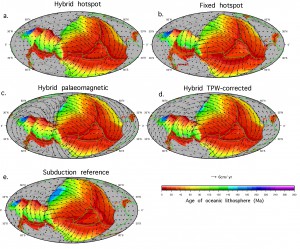 Absolute reference frames are a means of describing the motion of plates on the surface of the Earth over time, relative to a fixed point or frame. Multiple models of absolute plate motion have been proposed for the Cretaceous-Tertiary period, however, estimating the robustness and limitations of each model remains a significant limitation for refining both regional and global models of plate motion as well as fully integrated and time dependent geodynamic models. Here, we use a novel approach to compare five models of absolute plate motion in terms of their consequences for forward modelled deep mantle structure since at least 140 Ma. … Read more…
Absolute reference frames are a means of describing the motion of plates on the surface of the Earth over time, relative to a fixed point or frame. Multiple models of absolute plate motion have been proposed for the Cretaceous-Tertiary period, however, estimating the robustness and limitations of each model remains a significant limitation for refining both regional and global models of plate motion as well as fully integrated and time dependent geodynamic models. Here, we use a novel approach to compare five models of absolute plate motion in terms of their consequences for forward modelled deep mantle structure since at least 140 Ma. … Read more…
Global and regional plate motion models
The following table displays datasets relating to Global and regional plate motion models. Please cite the relevant publication when using these data. Contact Bianca Simonetta or Michael Chin to make changes to this table.
*The “grids” include age grids and spreading rate grids(availability varies).
| Short Description And Data | Timeframe | Reference |
|---|---|---|
| Shirmard et al. (2025) How Subduction Evolution and Tectonic Stability Drive Sediment-Hosted Mineralization Along Craton Edges. (download data) | 1800 - 0 Ma | Shirmard, H., Mather, B., Farahbakhsh E., and Müller, R. D. How Subduction Evolution and Tectonic Stability Drive Sediment-Hosted Mineralization Along Craton Edges. |
| Cao et al. (2024) Earth’s tectonic and plate boundary evolution over 1.8 billion years (download data) | 1800 - 0 Ma | Cao, X., Collins, A.S., Pisarevsky, S., Flament, N., Li, S., Hasterok, D. and Müller, R.D., 2024. Earth’s tectonic and plate boundary evolution over 1.8 billion years. Geoscience Frontiers, v.15, n. 2, p.101922, https://doi.org/10.1016/j.gsf.2024.101922. |
| Alfonso et al. (2024) A Modified Global Plate Model Including Quantitative Tomotectonic Plate Reconstruction of Western North America and the Eastern Pacific Basin (download data | grids) ~~~~ Modified Clennett et al. (2020)/Muller et al. (2019) model. | 170 - 0 Ma | Christopher P. Alfonso, R. Dietmar Müller, Ben Mather, Michele Anthony; Spatio-temporal copper prospectivity in the American Cordillera predicted by positive-unlabeled machine learning. GSA Bulletin 2024; doi: https://doi.org/10.1130/B37614.1 |
| Müller et al. (2022) A tectonic-rules-based mantle reference frame since 1 billion years ago (download data | grids) | 1000 - 0 Ma | Müller, R. D., Flament, N., Cannon, J., Tetley, M. G., Williams, S. E., Cao, X., Bodur, Ö. F., Zahirovic, S., and Merdith, A.: A tectonic-rules-based mantle reference frame since 1 billion years ago – implications for supercontinent cycles and plate–mantle system evolution, Solid Earth, 13, 1127–1159, https://doi.org/10.5194/se-13-1127-2022, 2022. |
| Zahirovic et al. (2022) Subduction kinematics and carbonate platform interactions (download data | grids) | 400 - 0 Ma | Zahirovic, S., Eleish, A., Doss, S., Pall, J., Cannon, J., Pistone, M., Tetley, M. G., Young, A., & Fox, P. (2022). Subduction kinematics and carbonate platform interactions. Geoscience Data Journal, 9(2), p.371-383, https://doi.org/10.1002/gdj3.146. |
| Merdith et al. (2021) Extending full-plate tectonic models into deep time: Linking the Neoproterozoic and the Phanerozoic (download data) | 1000 - 0 Ma | Andrew S. Merdith, Simon E. Williams, Alan S. Collins, Michael G. Tetley, Jacob A. Mulder, Morgan L. Blades, Alexander Young, Sheree E. Armistead, John Cannon, Sabin Zahirovic, R. Dietmar Müller, (2021). Extending full-plate tectonic models into deep time: Linking the Neoproterozoic and the Phanerozoic, Earth-Science Reviews, Volume 214, 2021, 103477, ISSN 0012-8252, https://doi.org/10.1016/j.earscirev.2020.103477. |
| Clennett et al. (2020) A Quantitative Tomotectonic Plate Reconstruction of Western North America and the Eastern Pacific Basin (download data | grids) | 170 - 0 Ma | Clennett, E., Sigloch, K., Mihalynuk, M. G., Seton, M., Hosseini, K., Mohammadzaheri, A., Johnston, S.T., & Müller, R.D. (2020). A Quantitative Tomotectonic Plate Reconstruction of Western North America and the Eastern Pacific Basin, Geochemistry, Geophysics, Geosystems, https://doi.org/10.1029/2020GC009117 |
| Müller et al. (2019) A Global Plate Model Including Lithospheric Deformation Along Major Rifts and Orogens Since the Triassic (download data | grids) | 250 - 0 Ma | Müller, R. D., Zahirovic, S., Williams, S. E., Cannon, J., Seton, M., Bower, D. J., Tetley, M. G., Heine, C., Le Breton, E., Liu, S., Russell, S. H. J., Yang, T., Leonard, J., and Gurnis, M. (2019), A global plate model including lithospheric deformation along major rifts and orogens since the Triassic. Tectonics, vol. 38, https://doi.org/10.1029/2018TC005462. |
| Young et al. (2018) Global kinematics of tectonic plates and subduction zones since the late Paleozoic Era. (download data) | 410 - 0 Ma | Young, A., Flament, N., Maloney, K., Williams, S., Matthews, K., Zahirovic, S., Müller, R.D., Global kinematics of tectonic plates and subduction zones since the late Paleozoic Era, Geoscience Frontiers (2018), doi: 10.1016/j.gsf.2018.05.011." |
| Merdith et al. (2017) Rodinia model from Gondwana Research (download data) | 1000 - 520 Ma | Merdith, A.S., Collins, A.S., Williams, S.E., Pisarevsky, S., Foden, J.F., Archibald, D., Blades, M.L., Alessio, B.L., Armistead, S., Plavsa, D. and Clark, C., 2017. A full-plate global reconstruction of the Neoproterozoic. Gondwana Research, https://doi.org/10.1016/j.gr.2017.04.001. |
| Matthews et al. (2016) Late Paleozoic to present-day global model (Global and Planetary Change) (download data) Note: these files have the Pacific correction applied | 410 - 0 Ma | Matthews, K.J., Maloney, K.T., Zahirovic, S., Williams, S.E., Seton, M., and Müller, R.D. 2016, Global plate boundary evolution and kinematics since the late Paleozoic : Global and Planetary Change, Vol 146, 226-250, https://doi.org/10.1016/j.gloplacha.2016.10.002. |
| Zahirovic et al. (2016) Eastern Tethys refinements to Muller et al. (2016) AREPS model. (download data | grids) | 230 - 0 Ma | Zahirovic, S., Matthews, K. J., Flament, N., Müller, R. D., Hill, K. C., Seton, M., and Gurnis, M., 2016, Tectonic evolution and deep mantle structure of the eastern Tethys since the latest Jurassic. Earth Science Reviews, v. 162, p. 293-337, https://doi.org/10.1016/j.earscirev.2016.09.005. |
| Müller et al. (2016) Late Triassic to present-day global model (Annual Review of Earth and Planetary Sciences) (download data | grids) *NOTE: these files have the Pacific correction applied | 230 - 0 Ma | Müller, R.D., Seton, M., Zahirovic, S., Williams, S.E., Matthews, K.J., Wright, N.M., Shephard, G.E., Maloney, K.T., Barnett-Moore, N., Hosseinpour, M., Bower, D.J., Cannon, J., 2016, Ocean basin evolution and global-scale plate reorganization events since Pangea breakup: Annual Reviews of Earth and Planetary Sciences, v.44, p.107-138, https://doi.org/10.1146/annurev-earth-060115-012211. |
| Scotese (2016) PALEOMAP reconstructions (download data) | 1100 - 0 Ma | Scotese, C.R., 2016. PALEOMAP PaleoAtlas for GPlates and the PaleoData Plotter Program, PALEOMAP Project. |
| Zahirovic et al. (2014) and Gibbons et al. (2015) A tectonic model reconciling evidence for the collisions between India, Eurasia and intra-oceanic arcs of the central-eastern Tethys (Shephard et al., 2013) (download data) | 200 - 0 Ma | Zahirovic, S., Seton, M., and Müller, R., 2014, The Cretaceous and Cenozoic tectonic evolution of Southeast Asia: Solid Earth (EGU), v.5, p.227-273, https://doi.org/10.5194/se-5-227-2014. ~~~~ Gibbons, A., Zahirovic, S., Müller, R., Whittaker, J., and Yatheesh, V., 2015, A tectonic model reconciling evidence for the collisions between India, Eurasia and intra-oceanic arcs of the central-eastern Tethys: Gondwana Research, v.28(2), p.451-492, https://doi.org/10.1016/j.gr.2015.01.001. |
| Shephard et al. (2013) Circum-Arctic refinements of the Seton et al. (2012) model (download data) | 200 - 0 Ma | Shephard, G. E., Müller, R. D., and Seton, M., 2013, The tectonic evolution of the Arctic since Pangea breakup: Integrating constraints from surface geology and geophysics with mantle structure: Earth-Science Reviews, v. 124, p. 148-183, https://doi.org/10.1016/j.earscirev.2013.05.012. |
| Seton et al. (2012) Post-Pangea model from Earth-Science Reviews (download data | grids) | 200 - 0 Ma | Seton, M., Müller, R., Zahirovic, S., Gaina, C., Torsvik, T., Shephard, G., Talsma, A., Gurnis, M., Turner, M., Maus, S., and Chandler, M., 2012, Global continental and ocean basin reconstructions since 200 Ma: Earth-Science Reviews, v. 113, no. 3-4, p. 212-270, https://doi.org/10.1016/j.earscirev.2012.03.002. |
| Shephard et al. (2012) Global models with alternative absolute reference frames (download data) | 140 - 0 Ma | Shephard, G. E., Bunge, H. P., Schuberth, B. S. A., Müller, R., Talsma, A., Moder, C., and Landgrebe, T., 2012, Testing absolute plate reference frames and the implications for the generation of geodynamic mantle heterogeneity structure: Earth and Planetary Science Letters, v. 317, p. 204-217, https://doi.org/10.1016/j.epsl.2011.11.027. |
| Gurnis et al. (2012) First plate motion model using the GPlates continuously closing plate polygon algorithm (download data) | 140 - 0 Ma | Gurnis, M., Turner, M., Zahirovic, S., DiCaprio, L., Spasojevic, S., Müller, R., Boyden, J., Seton, M., Manea, V., and Bower, D., 2012, Plate Tectonic Reconstructions with Continuously Closing Plates: Computers & Geosciences, v. 38, no. 1, p. 35-42, https://doi.org/10.1016/j.cageo.2011.04.014. |
| Li et al. (2008) Rodinia model from Precambrian Research (download data) | 1100 - 530 Ma | Li, Z.X., Collins, A.S., Davidson, A., De Waele, B., Ernst, R.E., Fitzsimons, I.C.W., Fuck, R.A., Gladkochub, D.P., Jacobs, J., Karlstrom, K.E., Lu, S., Natapov, L.M., Pease, V., Thrane, K., and Vernikovsky, V., 2008, Assembly, configuration, and break-up history of Rodinia: A synthesis: Precambrian Research v. 160, p. 179–210. |
Constraining the Jurassic extent of Greater India: Tectonic evolution of the West Australian margin
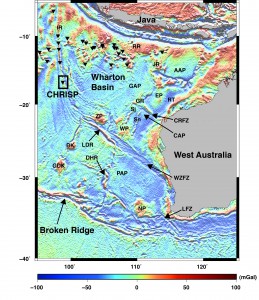 We present the Indian Ocean plate tectonic model accompanying the study of Gibbons et al., (2012). This work details the first regional-scale tectonic model of the breakup of East Gondwana. Our model shows that the breakup of East Gondwana started with the migration of a continental sliver, Argoland, in the Late Jurassic and was followed by breakup between Greater India and Australia-Antarctica in the Early Cretaceous, involving spreading reconfigurations, which left several sunken continental plateaus of Indian crust on the Australian plate. New evidence from seafloor off northwest Australia also shows that the majority of Greater India reached only about halfway up the West Australian margin, to the Wallaby-Zenith Plateaus. … Read more…
We present the Indian Ocean plate tectonic model accompanying the study of Gibbons et al., (2012). This work details the first regional-scale tectonic model of the breakup of East Gondwana. Our model shows that the breakup of East Gondwana started with the migration of a continental sliver, Argoland, in the Late Jurassic and was followed by breakup between Greater India and Australia-Antarctica in the Early Cretaceous, involving spreading reconfigurations, which left several sunken continental plateaus of Indian crust on the Australian plate. New evidence from seafloor off northwest Australia also shows that the majority of Greater India reached only about halfway up the West Australian margin, to the Wallaby-Zenith Plateaus. … Read more…
Insights on the kinematics of the India-Eurasia collision from global geodynamic models
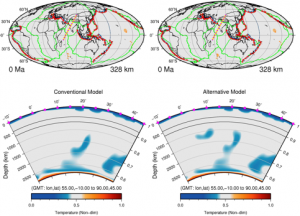 We present the input plate motion models and results from the study by Zahirovic et al. (2012) on the India-Eurasia collision using linked kinematic and geodynamic models.
We present the input plate motion models and results from the study by Zahirovic et al. (2012) on the India-Eurasia collision using linked kinematic and geodynamic models.
Two end-member scenarios of the India-Eurasia collision were tested. The conventional model invokes long-lived Andean-style subduction along southern Eurasia until continental collision between a maximum extent Greater India and Lhasa at ~60 Ma. … Read more…
The tectonic fabric of the ocean basins
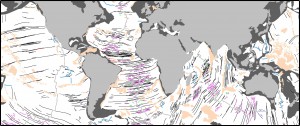 We present a global community data set of fracture zones (FZs), discordant zones, propagating ridges, V-shaped structures and extinct ridges, digitized from vertical gravity gradient (VGG) maps.
We present a global community data set of fracture zones (FZs), discordant zones, propagating ridges, V-shaped structures and extinct ridges, digitized from vertical gravity gradient (VGG) maps.
… Read more…
Full-fit, palinspastic reconstruction of the conjugate Australian-Antarctic margins
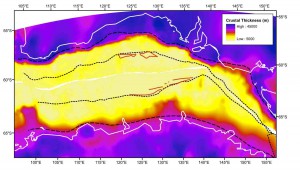 Despite decades of study the pre-rift configuration and early rifting history between Australia and Antarctica is not well established. The plate boundary system during the Cretaceous includes the evolving Kerguelen-Broken Ridge Large Igneous Province in the west as well as the conjugate passive and transform margin segments of the Australian and Antarctic continents. … Read more…
Despite decades of study the pre-rift configuration and early rifting history between Australia and Antarctica is not well established. The plate boundary system during the Cretaceous includes the evolving Kerguelen-Broken Ridge Large Igneous Province in the west as well as the conjugate passive and transform margin segments of the Australian and Antarctic continents. … Read more…
Dynamic subsidence of eastern Australia during the Cretaceous
![]() During the Early Cretaceous Australia’s eastward passage over sinking subducted slabs induced widespread dynamic subsidence and formation of a large eperiogenic sea in the eastern interior. Despite evidence for convergence between Australia and the paleo-Pacific, the subduction zone location has been poorly constrained. Using coupled plate tectonic-mantle convection models, we test two end-member scenarios, one with subduction directly east of Australia’s reconstructed continental margin, and a second with subduction translated ~1000 km east, implying the existence of a back-arc basin. Our models incorporate a rheological model for the mantle and lithosphere, plate motions since 140 Ma and evolving plate boundaries. While mantle rheology affects the magnitude of surface vertical motions, timing of uplift and subsidence depends on plate boundary geometries and kinematics. … Read more…
During the Early Cretaceous Australia’s eastward passage over sinking subducted slabs induced widespread dynamic subsidence and formation of a large eperiogenic sea in the eastern interior. Despite evidence for convergence between Australia and the paleo-Pacific, the subduction zone location has been poorly constrained. Using coupled plate tectonic-mantle convection models, we test two end-member scenarios, one with subduction directly east of Australia’s reconstructed continental margin, and a second with subduction translated ~1000 km east, implying the existence of a back-arc basin. Our models incorporate a rheological model for the mantle and lithosphere, plate motions since 140 Ma and evolving plate boundaries. While mantle rheology affects the magnitude of surface vertical motions, timing of uplift and subsidence depends on plate boundary geometries and kinematics. … Read more…
